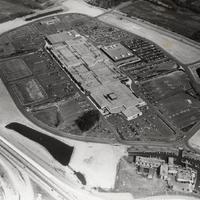Briarwood Mall and Land Use Debates
In the early 1970s, as the city of Ann Arbor sought to create an “overall image of itself,” the Briarwood Mall controversy placed competing visions for the future of Ann Arbor against one another. The disagreement became a point of contention between mayoral candidates, city council members, and Ann Arbor citizens, demonstrating the attitudes and arguments that city planning disputes would involve in the years to come.
The dispute began in 1971 when the Ann Arbor Planning Commission approved the changing of over one hundred acres of land at the intersection of State Road and I-94 from agricultural to commercial to allow for the construction of a shopping center proposed by three major department stores, Hudson’s, Penny’s and Sears. The developer, Richard P. Kughn, was eager to build a $30 million, massive shopping center and to boost retail sales in Ann Arbor by drawing in shoppers from across Washtenaw County . The proposed center would be named Briarwood, a name which its environmentalist opponents, such as Richard Ahern, an Ann Arbor architect, found particularly ironic, quipping that if all went according to the developer’s plan “there will be no woods and no briar patch” left. Ann Arbor residents recognized “the community threat” that the plan posed towards local businesses, especially in the downtown area, nearby traffic, and the environment. The Ecology Center, the Sierra Club, downtown merchants, and other local organizations quickly mobilized to develop an organized resistance with committees, petitions, and ads devoted to the cause.
“We were very interested in public attitudes toward the petition against Briarwood. The most prevalent reason we heard for not signing was that while they were sure it would be a horrible blight on the landscape, a death-knell to downtown Ann Arbor, and an ecological catastrophe, it was sure to come anyway, so why fight it? It is this fatalism which now seems to infect not only much of our citizenry, but also the City Council, which will be responsible for the further deterioration and suburbanization (in the worst sense) of Ann Arbor.” - Ecology Reports, March 9, 1971
After several months of long council debates about the ecological, economic, and planning considerations of the proposed project, City Council approved the complex in a 6-4 vote in June 1971. The next month, the local Sierra Club chapter pursued a lawsuit on behalf of a local resident, Mrs. Maryann Reimold, to try to halt the planning process. Despite the Ecology Center’s efforts to raise funds for the suit, the Sierra Club ran out of money for legal fees and had to drop the case. Although the environmentalists lost that battle, the work of the Ecology Center, the Sierra Club and other local groups ensured that environmental and community concerns were heard and would continue to be a crucial consideration in decisions about the city’s future growth.



